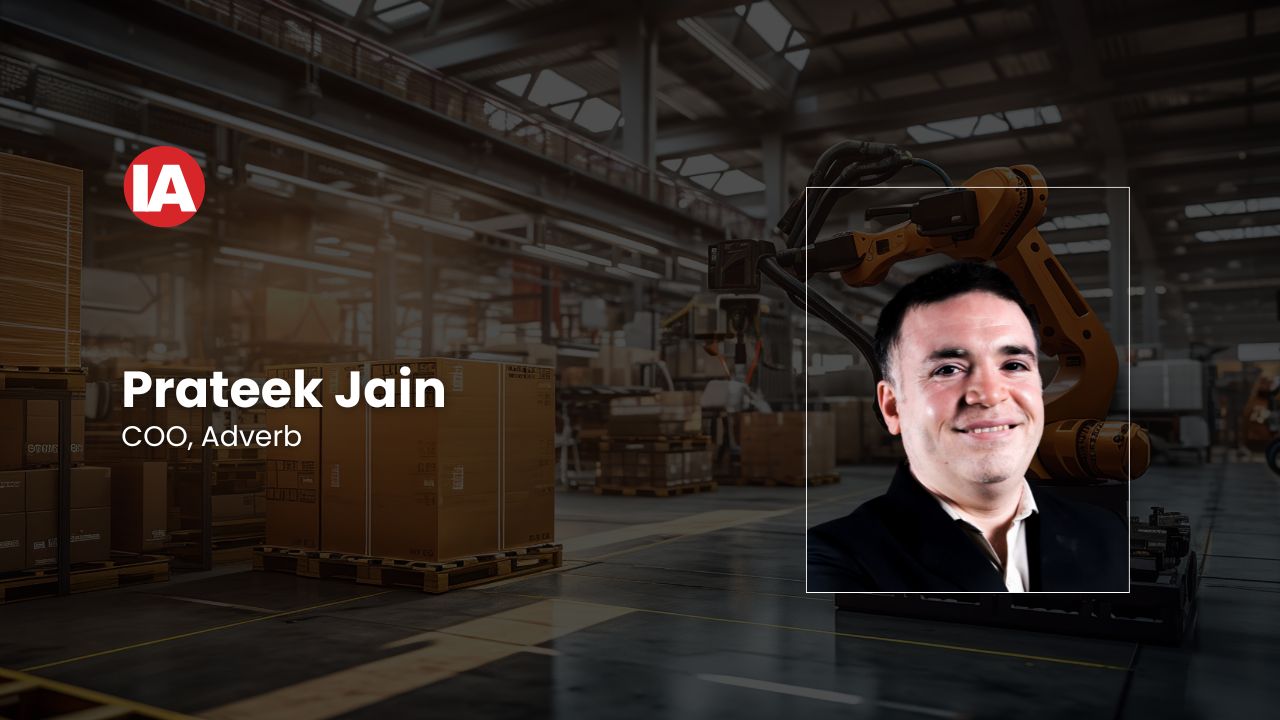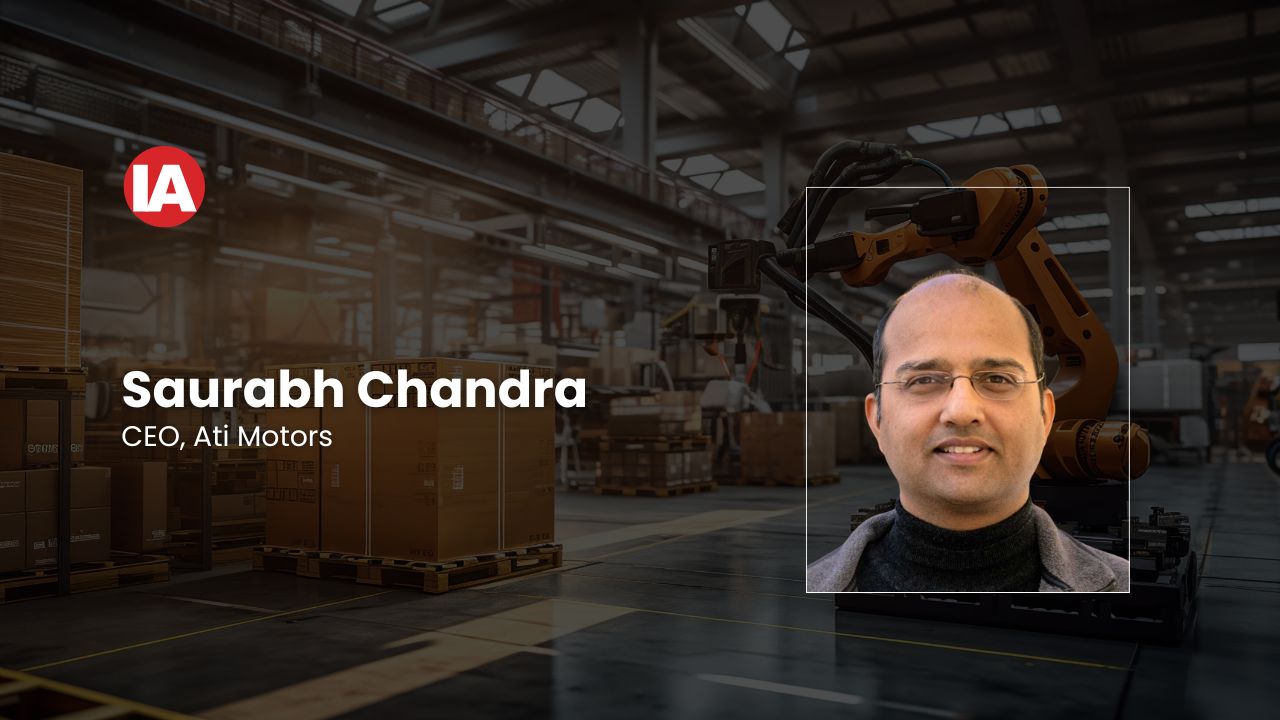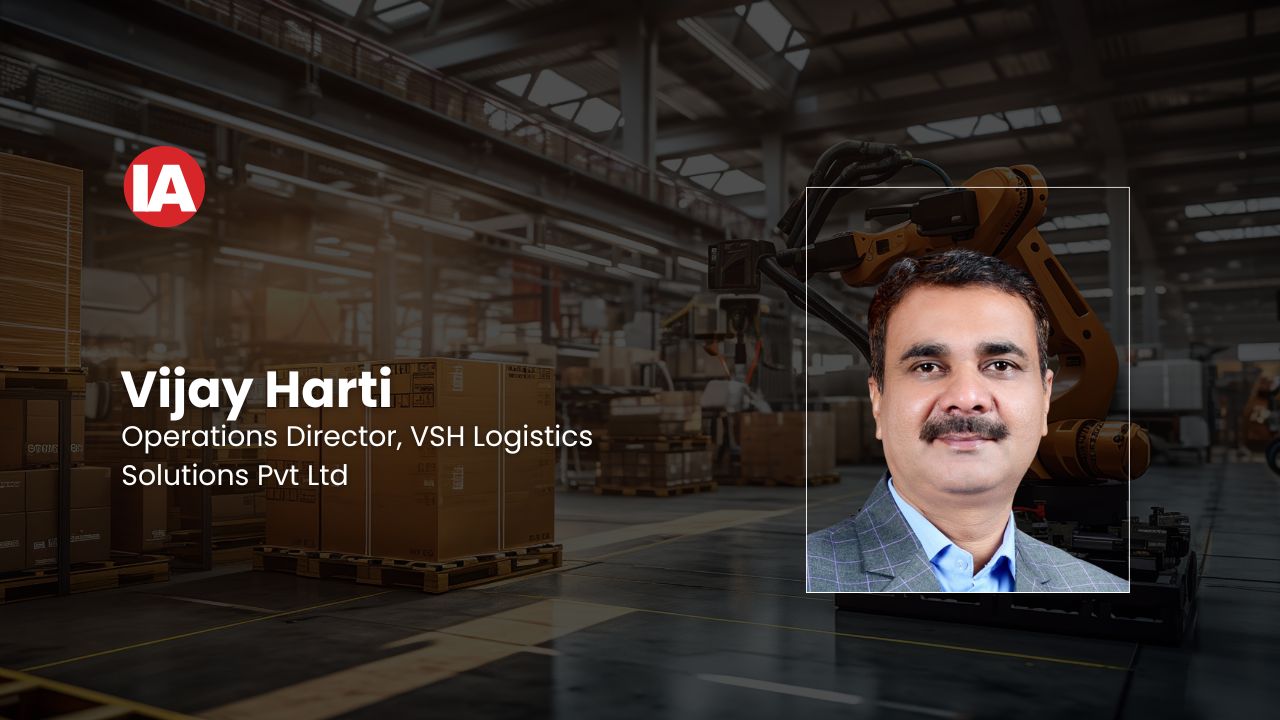
Trends Shaping Intralogistics & Packaging Automation
Intralogistics and packaging automation are rapidly evolving, driven by rising e-commerce demand, technological innovation, and the need for supply chain resilience. Key trends include the adoption of AI, IoT, and robotics, enhancing efficiency, predictive maintenance, and real-time decision-making. Flexible solutions like automated mobile robots (AMRs) and automated guided vehicles (AGVs) are expediting warehouse tasks while reducing manual dependency.
![[object Object]](https://admin.industrialautomationindia.in/storage/cover_stories/coverstory-JDcUr4BG6SpMtTwZ6N7P0Ue8nA06tblLzR8wtyDl.jpg)
Trends Shaping Intralogistics & Packaging Automation
Growing adoption of flexible and scalable automation solutions are among recent trends.
Intralogistics automation is the use of technology to replace manual labor in the management and optimisation of a warehouse or distribution centre’s internal logistics. It involves using equipment to perform repetitive tasks, such as moving goods from receiving to storage and then to shipping. With a host of systems and equipment like robotic picking and packing, automated storage and retrieval systems (AS&RS), conveyor systems, warehouse management software (WMS), automated guided vehicles (AGVs), automated mobile robots (AMRs) and packaging machinery, automation improves efficiency, accuracy, safety, and overall equipment effectiveness (OEE) while allowing for quick changeovers between formats. Against this backdrop, it would be interesting to explore what are the most significant trends seen shaping the intralogistics automation sector?
“The increase of e-commerce and investments in digital infrastructure are driving growth in India's intralogistics automation sector, which is enjoying economic expansion. Robotics, Artificial Intelligence (AI), and the Internet of Things (IoT) are becoming increasingly popular as means of improving operational efficiency and gaining real-time data insights. Businesses are adopting both AMRs and AGVs to expedite warehouse chores and reduce dependency on manual labour. This helps address space restrictions in tightly packed warehouses in India,” says Dhritiman Chakraborty, Director Operations, Ingram Micro India Private Limited. According to him, companies like Addverb Technologies and GreyOrange are pioneering in robotics and AS&RS, which have become essential for scaling warehouse operations to meet the surging demand.
Vijay Harti, Operation Director, VSH Logistics Solutions Pvt Ltd, summarises the emerging trends as follows:
1. AI and Machine Learning (ML) in Automation
- Predictive Maintenance: AI predicts equipment failures, reducing downtime and maintenance costs.
- Computer Vision and Robotics: AI enhances robots' capabilities for sorting, picking, and placing.
2. Warehouse Management and Execution Systems (WMS/WES)
- Seamless Integration: Modern WMS/WES integrates with automation for smooth warehouse operations.
- AI-powered Solutions: AI optimises inventory tracking, order processing, and real-time updates.
3. Last-Mile Delivery Automation
- Micro-Fulfilment Centres: Automated centres near customers speed up delivery in urban areas.
4. E-commerce Growth and On-Demand Warehousing
- Higher Automation Demand: E-commerce drives investment in automation for handling orders.
- On-Demand Warehousing: Flexible storage solutions help manage fluctuating demand.
5. Training Ground Staff
- Focus on new automation tools to improve warehouse efficiency and adaptability.
“The intralogistics automation sector is witnessing transformative changes that are redefining how supply chains operate globally. One of the most significant trends driving this evolution is the growing demand for greater efficiency and precision. With the explosive growth of e-commerce, companies are under increasing pressure to manage higher volumes of orders with shorter lead times. This demand for speed, accuracy, and seamless delivery is compelling organisations to embrace automation solutions that can streamline operations and ensure scalability, without compromising on reliability,” says Prateek Jain, Chief Operations Officer at Addverb.
As far as technology goes, there are a host of options, blending conventional equipment with robotic and IoT capabilities; but how are emerging technologies like AI, IoT, and robotics enhancing efficiency, predictive maintenance, and real-time decision-making in intralogistics automation?

“Technologies like AI, IoT, and robotics are transforming intralogistics by enabling higher efficiency, predictive maintenance, and real-time decision-making in several impactful ways, both globally and in India,” says Sunil David, Digital Technology Consultant, and cites Efficiency in Operation as an example, and the way this works in practice:
- AI-Driven Optimisation: AI algorithms can analyse large sets of data, including order volume, stock levels, and shipping schedules, to streamline warehouse management and optimise picking, packing, and sorting processes.
- Robotic Automation: Robotics brings speed and precision to labour-intensive tasks like order picking, reducing human error and labour costs.
- AGVs and AMRs: These are essential for handling goods movement in warehouses. They can navigate complex layouts, avoid obstacles, and transport goods efficiently, allowing for flexible and scalable logistics solutions. Large warehouses in India, especially in metro cities, are starting to deploy AMRs to optimise space utilisation.
Saurabh Chandra, CEO, Ati Motors, draws attention to the fact that AI, IoT (Internet of Things), and robotics are transforming intralogistics automation, creating smart warehouses that predict and adapt in real time. “These technologies drive seamless operations and proactive maintenance, alerting teams to potential issues before they lead to breakdowns. By integrating IoT, AI, and AMRs, businesses enable just-in-time operations, enhancing efficiency and material flow. Together, they are redefining Industry 4.0, making operations more connected, responsive, and resilient,” he says, and elaborates them in brief:
- AI optimises workflows by analysing data to identify patterns, predict equipment failures, and improve inventory management.
- IoT enables real-time monitoring of inventory levels, equipment performance, and environmental conditions, providing greater visibility across operations.
- Robotics, particularly AMRs, enhances efficiency and safety by handling tasks across indoor and outdoor environments.

“When it comes to changing India's intralogistics business, AI, IoT and robotics play a vital role since they improve forecasting accuracy and enable predictive maintenance. AI-powered technologies assist businesses in predicting demand and adjusting inventory levels, hence reducing the likelihood of stockouts and surplus inventory. Real-time monitoring of commodities is provided by IoT sensors, which is vital for industries that deal with perishable things because these sensors help maintain product integrity while it is in transit,” observes Dhritiman Chakraborty. “Companies can operate around the clock and enhance their response times to market needs – thanks to robotics – which further boosts productivity by automating repetitive processes such as sorting and packaging. AI, IoT, and robotics taken together are creating a linked and highly responsive logistics environment in India that lets businesses satisfy customer needs while preserving operational efficiency,” he notes.
There are many synergies between Intralogistics Automation and Packaging Automation as both make extensive use of technology to improve the efficiency and accuracy of warehouse and distribution centre processes. These high-growth sectors have developed an interesting overlap and many vendors are now catering to this demand to utilise the last section of warehouse where packaging, weighing and labeling occurs before shipping. In what ways is the integration between intralogistics and packaging automation evolving? More importantly, how are these two sectors creating synergies?
“The integration of intralogistics and packaging automation is transforming supply chains for greater efficiency, cost-effectiveness, and sustainability,” says Vijay Harti, who describes the key developments as:
1. End-to-End Automation: Seamless systems streamline goods flow from storage to shipping, reducing manual handling, errors, and speeding up order fulfilment.
2. Increased Efficiency: Synchronised operations in picking, sorting, and packaging boost throughput, while scalable automation adapts to fluctuating demand.
3. Sustainability: Automated packaging creates right-sized packages, reducing waste and using eco-friendly materials to lower the environmental impact.
4. Enhanced Traceability: Integration with Warehouse Management Systems (WMS) ensures product traceability, compliance, and accurate automated labelling.
5. Optimised Order Fulfilment: Automated quality control and order-specific packaging enhance customer satisfaction by reducing errors and improving delivery accuracy.

“While the focus here is on intralogistics, it's essential to highlight the increasing integration of various operational processes within the supply chain. As automation technologies advance, companies are looking for ways to create synergies across different areas of their operations. For instance, robotic pick-and-place applications using advanced grippers enable faster handling of materials and facilitate smoother operations in intralogistics,” says Prateek Jain. “For example, integrating AS&RS with AMRs allows for seamless movement of goods within a facility, improving efficiency and reducing the time required to fulfill orders. Moreover, as companies invest in automation solutions, they are also prioritising interoperability. Ensuring that different automated systems can communicate effectively with one another is crucial for optimising operations. This interoperability enables businesses to create a more cohesive workflow, enhancing responsiveness and adaptability in their intralogistics processes,” he elaborates.
According to Sunil David, the integration of intralogistics and packaging automation is evolving to create highly efficient, adaptable, and sustainable supply chain operations. These sectors are increasingly working together to streamline processes, improve product handling, reduce waste, and optimise space and resources. Among the key areas of impact are:
1. Streamlined Material Flow and Enhanced Efficiency
2. Customisable and Flexible Packaging Options, and
3. Enhanced Product Tracking and Inventory Control.
“India’s logistics and packaging sectors, while still maturing, are embracing automation to cater to the fast-growing e-commerce and manufacturing demands. Driven by the National Logistics Policy and initiatives like Make in India, PLI schemes, businesses are increasingly investing in automation and technology integration to improve end-to-end efficiency. In summary, the close integration of intralogistics and packaging automation is a key enabler of a more resilient, efficient, and sustainable supply chain ecosystem,” elaborates Sunil David.
How is automation in intralogistics and packaging contributing to supply chain resilience in the face of global disruptions?
According to Saurabh Chandra, automation in intralogistics and packaging strengthens supply chain resilience during global disruptions by enhancing efficiency, flexibility, and responsiveness. Automated systems, like AMRs, streamline operations, reduce manual labour, and minimise errors, allowing for quick adaptations to challenges such as labour shortages or demand fluctuations. “Real-time data collection and analytics enable proactive monitoring and swift adjustments in inventory and routing, while scalability allows companies to easily adapt to changing market conditions. Additionally, improved safety and regulatory compliance, along with enhanced visibility across the supply chain, facilitate better decision-making and collaboration among partners, ultimately ensuring more stable operations during crises,” he explains.
“Automation strengthens the resilience of supply chains by making it possible to quickly adjust to global shocks such as changes in demand or delays in logistics implementation. Companies in India are able to function with minimum manual involvement due to automated technology, which reduces their reliance on people. This is especially important during times of manpower shortages. Monitoring the flow of products and making prompt adjustments, such as rerouting shipments, are both made easier with the assistance of real-time data from IoT-enabled tracking devices,” says Dhritiman Chakraborty. He notes that Indian businesses are creating stronger and more flexible supply chains that can survive worldwide interruptions by including automation into intralogistics and packaging, thereby guaranteeing continuity and stability in the face of uncertain events.
Vijay Harti believes automation in intralogistics and packaging enhances supply chain resilience by increasing flexibility, speed, and responsiveness in the face of global disruptions. Automated systems can quickly adapt to changing demand patterns, supply shortages, or labour constraints, allowing businesses to scale operations up or down without sacrificing efficiency. “Automation reduces dependency on human labour, which is crucial during disruptions like pandemics or workforce shortages. Robots, AI-driven systems, and automated warehouses ensure continuous operations with minimal downtime. Additionally, advanced data analytics in automation provides real-time visibility into the supply chain, enabling quicker decision-making, better forecasting, and proactive risk management, helping businesses to anticipate and respond effectively to disruptions,” he asserts.
Regardless of the synergies, there are crucial differences in the operations of intralogistics and packaging segments. In intralogistics, the emphasis is on management of the flow of materials and information within a company, including inventory management, order picking, and warehouse optimisation. Packaging automation, on the other hand, makes use of automated equipment to perform repetitive packaging tasks. Packaging automation can help mitigate issues like damaged products, overfilled containers, and excessive packaging material. It is important to understand how automation solutions in intralogistics and packaging differ across various industries, and what industry-specific trends are driving their adoption?
“Automation solutions in intralogistics and packaging vary according to industry-specific needs, driven by distinct trends like demand for customisation in CPG, regulatory compliance in pharmaceuticals, speed in e-commerce, and sustainability across sectors. These tailored solutions enable companies to stay competitive, responsive, and compliant in a rapidly evolving market,” says Sunil David. According to him, these are tailored to meet unique operational requirements, regulatory standards, and consumer expectations. These solutions differ and the industry-specific trends driving their adoption depend on:
1. E-commerce and Retail: heavily invest in automated picking, sorting, and packing systems to handle high order volumes and SKU diversity. AMRs, AS/RS and automated packaging machines streamline order fulfillment and last-mile delivery.
2. Food and Beverage: Automation in this sector focuses on precision and quality control, often using automated sorters, conveyors, and robotic arms with advanced sensors for tasks like sorting, packaging, and labelling.
3. Pharmaceuticals and Healthcare: In pharmaceuticals, automation includes precise picking systems, robotic arms for assembly, automated labelling, and packaging systems with temperature and contamination controls.

For Saurabh Chandra, automation solutions in intralogistics and packaging vary by industry, each shaped by specific needs and trends. In manufacturing, automation enhances production efficiency and just-in-time inventory, while the food and beverage sector prioritises compliance and cleanliness in packaging. “Key trends driving adoption include rising consumer demands for personalisation and faster delivery. E-commerce is leveraging AGVs for rapid order fulfillment, while pharmaceuticals focus on precision and regulatory compliance in their automated packaging processes. As industries evolve, tailored automation solutions are becoming essential for boosting productivity and maintaining competitive advantage,” he maintains.
“Based on their operations and difficulties, every industry in India is implementing automation in intralogistics and packaging to create tailored solutions, improving compliance, efficiency, and quality. These sector-specific trends are destined to keep changing as businesses try to satisfy the needs of a diversified and quickly expanding market. Depending on the operational demands of each industry in India, the requirements for automation are different,” says Dhritiman Chakraborty. “The pharmaceutical industry places a strong emphasis on precision and compliance through the implementation of automated technologies such as real-time tracking and temperature control for products that are particularly sensitive. The food and beverage sector places a high priority on both speed and cleanliness, and automated sorting and cleaning systems are utilised to maintain compliance with safety regulations. Automation places an emphasis on flexibility in the retail and e-commerce industries, with systems that are able to manage a wide variety of products and high order frequencies,” he elaborates.
How can automation solutions in intralogistics drive operational efficiency while supporting sustainability goals?
“Automation solutions in intralogistics play a crucial role in enhancing operational efficiency while supporting sustainability goals. By streamlining processes and reducing manual errors, companies can achieve higher productivity levels. For instance, automated systems can optimise inventory management, maintaining ideal stock levels without overproduction, which minimises waste and improves order fulfillment times. AMRs are another effective tool in this regard. Like we at Addverb utilise AMRs that can optimise their routes to minimise energy consumption by analysing real-time data and adjusting their paths based on the current state of the warehouse. This not only reduces unnecessary travel but also contributes to a smaller carbon footprint,” says Prateek Jain.
How are companies balancing human labour with automation in intralogistics and packaging, and what role does human-machine collaboration play in this transition?

According to Vijay Harti, companies are balancing human labour with automation in intralogistics and packaging through a hybrid approach that leverages the strengths of both. “Rather than replacing workers, businesses focus on human-machine collaboration, where automation handles repetitive, hazardous tasks, while humans concentrate on problem-solving and decision-making. Collaborative robots (cobots) work alongside humans in tasks like heavy lifting and sorting, boosting productivity and safety. Companies also invest in upskilling workers to manage these systems. This synergy between human expertise and machine efficiency enhances flexibility, resilience, and overall operational efficiency,” he explains.
“Companies are balancing human labour with automation in intralogistics and packaging by implementing a hybrid approach that combines the strengths of both. Automation is utilised for repetitive, high-volume tasks, allowing human workers to concentrate on more complex and decision-driven roles that require critical thinking and problem-solving skills,” says Saurabh Chandra, who also believes human-machine collaboration plays a pivotal role in this transition. “Workers often oversee automated systems, ensuring they function correctly and efficiently while also managing exceptions that automation may not handle effectively. This collaborative environment fosters operational flexibility, enabling humans to adapt quickly to workflow changes and troubleshoot issues as they arise. By leveraging both human expertise and automation, companies can enhance safety, reduce errors, and build a more resilient supply chain that can better respond to evolving demands and challenges,” he concludes.
Note: The responses of various experts featured in this story are their personal views and not necessarily of the companies or organisations they represent. The full interviews are hosted online at https://www.iedcommunications.com/interviews)